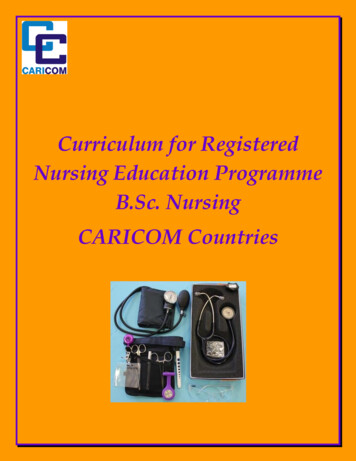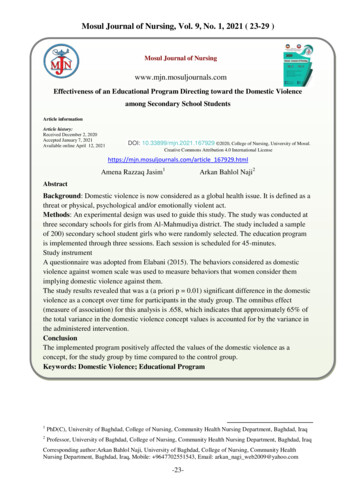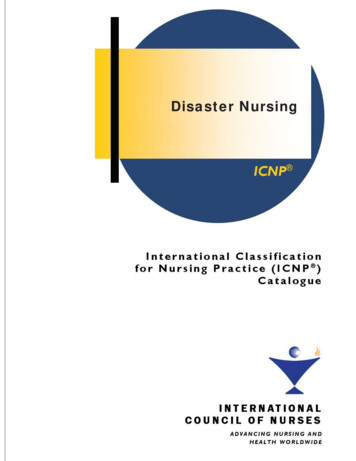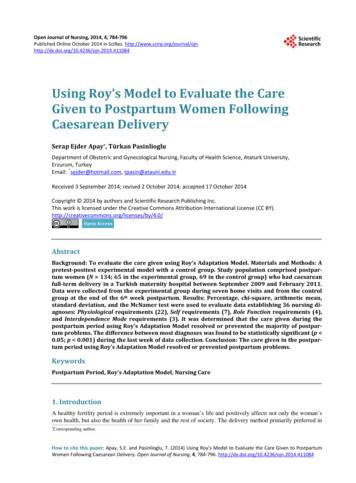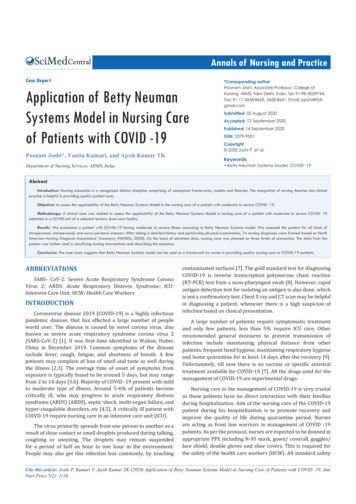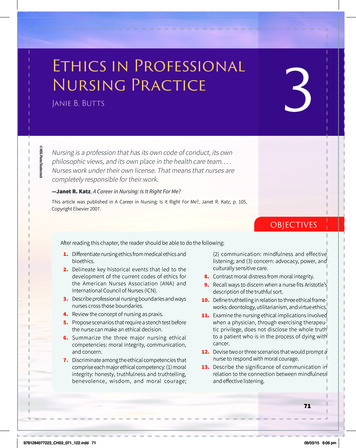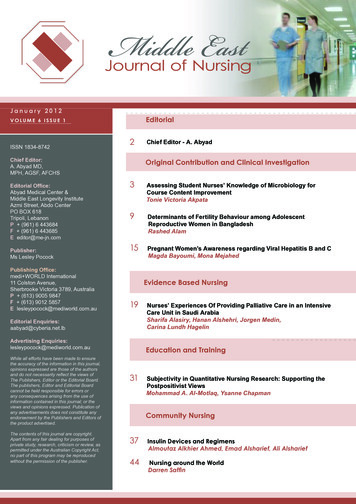
Transcription
Journal of NursingJanuary 2012EditorialVOLUME 6 ISSUE 1ISSN 1834-87422Chief Editor:A. Abyad MD,MPH, AGSF, AFCHSEditorial Office:Abyad Medical Center &Middle East Longevity InstituteAzmi Street, Abdo CenterPO BOX 618Tripoli, LebanonP (961) 6 443684F (961) 6 443685E editor@me-jn.comPublisher:Ms Lesley PocockPublishing Office:medi WORLD International11 Colston Avenue,Sherbrooke Victoria 3789, AustraliaP (613) 9005 9847F (613) 9012 5857E lesleypocock@mediworld.com.auOriginal Contribution and Clinical Investigation3Assessing Student Nurses’ Knowledge of Microbiology forCourse Content ImprovementTonie Victoria Akpata9Determinants of Fertility Behaviour among AdolescentReproductive Women in BangladeshRashed Alam15Pregnant Women’s Awareness regarding Viral Hepatitis B and CMagda Bayoumi, Mona MejahedEvidence Based Nursing19Editorial Enquiries:aabyad@cyberia.net.lbAdvertising Enquiries:lesleypocock@mediworld.com.auWhile all efforts have been made to ensurethe accuracy of the information in this journal,opinions expressed are those of the authorsand do not necessarily reflect the views ofThe Publishers, Editor or the Editorial Board.The publishers, Editor and Editorial Boardcannot be held responsible for errors orany consequences arising from the use ofinformation contained in this journal; or theviews and opinions expressed. Publication ofany advertisements does not constitute anyendorsement by the Publishers and Editors ofthe product advertised.The contents of this journal are copyright.Apart from any fair dealing for purposes ofprivate study, research, criticism or review, aspermitted under the Australian Copyright Act,no part of this program may be reproducedwithout the permission of the publisher.Chief Editor - A. AbyadNurses’ Experiences Of Providing Palliative Care in an IntensiveCare Unit in Saudi ArabiaSharifa Alasiry, Hanan Alshehri, Jorgen Medin,Carina Lundh HagelinEducation and Training31Subjectivity in Quantitative Nursing Research: Supporting thePostpositivist ViewsMohammad A. Al-Motlaq, Ysanne ChapmanCommunity Nursing37Insulin Devices and RegimensAlmoutaz Alkhier Ahmed, Emad Alsharief, Ali Alsharief44Nursing around the WorldDarren Saffin
EDITORIALFROM THE EDITORAbdulrazak AbyadMD, MPH, AGSF, AFCHS(Chief Editor)Editorial office:Abyad Medical Center &Middle East Longevity InstituteAzmi Street, Abdo CenterPO BOX 618Tripoli, LebanonP (961) 6 443684F (961) 6 443685E aabyad@cyberia.net.lbW www.amc-lb.comPublishing Office:medi WORLD International11 Colston AvenueSherbrooke 3789AustraliaE admin@mediworld.com.auw www.me-jn.comThis is the first issue this year andwe are looking for further growthof the journal which has stimulatedresearch in the area of nursingand scholarly work in this area.Our Middle East readership andacademic survey (see “MiddleEast Reader and Academic Survey2011-2012”) has shown the MEJN to be the second highest readjournal in the region (after theMEJFM), indicating a great needfor nursing related articles.A paper from Kuwait assessedstudents’ knowledge ofmicrobiology with a view toimproving the course content fornursing programs. The authorsstressed that microbiologycurriculum in pre-registrationnursing programs varies in differentcountries and institutions. They used an anonymous questionnairewhich was administered to 330nursing students and 14 facultymembers. Students in the Bachelorof Science in Nursing (BSN)program generally had higher meanscores than those in the AssociateDegree in Nursing (ADN). Theauthors concluded that areas ofpathogenicity and epidemiologyrequire more emphasis in thenursing microbiology curriculum.Another paper from Saudi Arabiaused a qualitative study designand semi structured interviews,explored the nurses’ experiencesof providing palliative care forcritically ill patients in an intensivecare unit in Saudi ArabiaThe authors stressed that in SaudiArabia the majority of deaths occurin the hospitals. However, thereare a few palliative care programsavailable to meet patients andfamilies’ needs. Six themes wereidentified and all themes reflectdifferent nurses’ experienceswhen they provide palliative carefor critically ill patients in theICU. The authors concluded thatcommunication was a barrier whennon-Arabic speaking nurses providepalliative care for critically ill patientsand their families. The authorsrecommended hospital managementto increase the number of Arabicspeaking nurses and to providemore translators in day shifts.A paper from Bangladesh looked atDeterminants of Fertility Behaviouramong Adolescent ReproductiveWomen in Bangladesh. Thechallenges and risks the youngpeople face during this periodimpact directly on their physical andemotional mental wellbeing. Theauthors used multivariate analysissuch as multiple classificationanalysis which has been used toidentify the important determinantsof children ever born. The studyresult shows that various socioeconomic and demographicvariables affect on adolescent’sfertility. These are adolescent’seducation, place of residence,religion, working status, breastfeeding etc. An inverse relation isfound between age at marriage,and fertility. Result shows thatfertility is highest in rural areasthan that of urban areas.A descriptive paper from Mohaielhospital looked at Pregnant Women’sAwareness regarding Viral HepatitisB and C . The author found thatout of 126 women only 34.9% hadsatisfactory knowledge about HBVand HCV. Misconceptions regardingHCV and HBV were very commonamong the study sample that 59.5%, 57.9%, 45.2% respectively considerfamily genetics, general toilets inmarkets and foods, as risk factors forinfection.The study findings reflect thatthere is unsatisfactory knowledgeregarding HBV and HCV amongwomen in the reproductiveyears. More efforts must befocused on correcting women’smisconceptions and educatingthem in healthy behaviorsthrough educational programs.A paper from Jordan lookedat subjectivity in quantitativenursing research. The authorsstressed that the credibility ofresearch is important for itsconsumption. Debates still existbetween supporters of differentparadigms as they disagree onwhat makes research credible,what makes it valid and to whatextent, and which methodologyis more appropriate. This paperpresents a comparative view ofcredibility between quantitative andqualitative paradigms by exploringthe issues of subjectivity andobjectivity in its methodologies.OFGNURSINGM I D D L E E A S T J OMIDDLEU R N AEASTL O FJOURNALNURSIN D e c JANUARYe m b e r 22012009/ January2010
ORIGINAL CONTRIBUTION AND CLINICAL INVESTIGATIONAssessing Student Nurses’ Knowledge of Microbiology for CourseContent ImprovementAbstractTonie Victoria AkpataBackground: Microbiologycurriculum in pre-registrationnursing programs variesin different countries andinstitutions. Thus, making adecision on the course contentcan be a challenge, especially ina new institution.Objective: To assess students’knowledge of microbiology witha view to improving the coursecontent for nursing programs.Methods: An anonymousquestionnaire was administeredto 330 nursing students and14 faculty members. Thequestionnaire contained 10questions on each subject areaof microbiology - infectioncontrol, immunity, epidemiologyand pathogenicity, with answerson a three-point Likert scale.Descriptive statistics, t-testand ANOVA were used todetermine the significance ofthe differences between scoresby different programs, levels ofenrollment and gender.Results: Students in Bachelorof Science in Nursing (BSN)program generally had highermean scores than those inAssociate Degree in Nursing(ADN). Students’ meanscores increased with level ofenrollment. Female studentshad significantly highermean scores in pathogenicitythan males (p 0.018). For allrespondents, knowledge ofmicrobiology was highest inimmunity and infection controland least in pathogenicity andepidemiology.Conclusion: Areas ofpathogenicity and epidemiologyrequire more emphasis inthe nursing microbiologycurriculum.Keywords: Nursing, knowledge,microbiology course content,curriculumCorrespondence:Tonie Victoria Akpata, Ph.DCollege of Nursing, The Public Authority for Applied Education and Training(PAAET)Al- Shuwaikh, KuwaitTelephone: 0096567670598Fax number: 00965 22315702Email: vicakpata@hotmail.comIntroductionMicrobiology is one of the biologicalscience courses required bynursing institutions; however, themicrobiology course content variesfrom one institution to another(Goetz et al., 1992; Choe & Shin,1999). Goetz (1992) reported that49 percent of nursing institutionsin the USA required students totake a microbiology course beforeclinical experience; some institutionsoffered only infection control andimmunization as their microbiologycourse content. However, Reynolds(2006) felt that infection control,transmission of diseases andepidemiology are areas that shouldbe included in the microbiologycourse for nurses. Knowledgeof these areas could reduceoccupational risk of nursing students,as was reported by Atulomah &Oladepo (2002). In a study by Davis(2010) in the UK, nursing studentsreported that the bioscience contentof their pre-registration nursingeducation was inadequate.The present study assessedstudents’ knowledge of four subjectareas of microbiology- infectioncontrol, immunity, epidemiologyand pathogenicity. The resultswill be helpful in determining theareas requiring improvement soas to enhance nursing students’knowledge of microbiology.Review of LiteratureBiosciences taught in preregistration nursing programsinclude anatomy, physiology,biochemistry and microbiology.MIDDLE EAST JOURNAL OF NURSING JANUARY 2012Henderson (2000) reported thatthe Georgia Board of Nursing inthe USA, mandated that nursingcurricula should contain naturalsciences, including microbiology.Reynolds (2006) reported theimportance of microbiology tonursing students. Literature indicatespoor performance of students inbiosciences, including microbiology(Jordan et al., 1999; Davis, 2010).Wong &Wong (1999) observedthat performance in biosciencestogether with grade point averageof nursing courses in years 3 and 4contributed significantly to studentsuccess in the nursing program(p 0.001). Furthermore, Campbell& Dickson (1996) reported thatgrade point averages in nursing andscience courses were the greatestcognitive predictors of NCLEX-RNexamination success. In addition,performance in microbiology wasassociated with the score in thefinal examination as well as theprofessional licensure examinations.Knowledge of microbiology isessential for the understanding of thepathogenesis of infectious diseasesand infection control. Atulomah &Oladepo (2002) in Nigeria attributedoccupational risks from HIV/AIDSamong nursing and midwiferystudents to poor knowledge ofmicrobiology. Similarly, DennySmith et al. (2006) reported thatfemale nursing students’ inadequateknowledge of microbiology put themat risk of human papillomavirus andcervical cancer. Thus, Trnobranski(1993) stressed the need for nursesto understand disease processessufficiently to practice safely.MIDDLE EAST JOURNAL OF NURSING JULY 2009
ORIGINAL CONTRIBUTION AND CLINICAL INVESTIGATIONKyriacos et al. (2005) suggestedthat the curriculum content ofmicrobiology must equip nurses indeveloping countries, such as SouthAfrica, to meet their expanding rolesas leaders in health care clinics.In fact, doctors and service usersexpect of nurses a higher level ofknowledge of biosciences thanthey actually have (Davis, 2010).Staff nurses have been reportedto express lack of confidencein articulating their knowledgeto patients and other healthprofessionals (Courtenay, 1991;Clancy et al., 2000).As the knowledge of the variousareas of microbiology impactdifferently on clinical practice, itis of interest to evaluate students’performance in the various areas ofthe subject.AimThe aim of this study was to assessstudents’ knowledge of microbiologywith a view to improving the coursecontent for pre- registration nursingprograms.Definition of termsCourse content in this study refers tofour subject areas of microbiology,namely: infection control, immunity,epidemiology and pathogenicity.Study settingThe College of Nursing is the onlyinstitution, in Kuwait, admittinghigh school graduates for nursingtraining (Al-Kandari et al., 2009).Established by decree in November,2002, the College offers twoprograms: Bachelor of Science inNursing (BSN) which runs for fouryears and Associate Degree inNursing (ADN) that has five levelseach being one semester of fourmonths. Microbiology is compulsoryfor the nursing programs so, there isneed for enhancement of students’knowledge.Previous reports have focused onthe relevance of basic sciences tonursing practice, or as a predictor ofsuccess in nursing programs. Thereappears to be few studies on nursingstudents’ knowledge of microbiology as a basis for evaluation ofmicrobiology course content.The aim of this study was,therefore, to assess the knowledgeof microbiology among nursingstudents in the ADN and BSNprograms against a standard scoreby registered nurses who wereclinical teachers in the College ofNursing.MethodsEthical approvalApproval for this research projectwas given by the ResearchCommittees of the College ofNursing and the Public Authorityfor Applied Education andTraining (PAAET), Kuwait. Ethicalconsiderations were given in the useof human subjects and their informedconsent. The purpose of the studywas described in writing and alsoexplained to all the students beforedistribution of the questionnaire tothose willing to participate. Theirconsent was expressed by theirresponding to the questionnaire.QuestionnaireThe instrument for the researchstudy was an anonymousquestionnaire.The first section of the questionnairedealt with demographic informationon nationality, gender, collegeprogram, level of enrollment, and ifrespondent had previously studiedmicrobiology. The second sectioncomprised ten questions on each offour subject areas of microbiologynamely; infection control, immunity,epidemiology and pathogenicity.Answers were on a three -pointLikert scale of: I agree, I do notknow, and I disagree.ProcedureAn anonymous self-administeredquestionnaire was distributed tonursing students in a classroomsetting, under the supervision of afaculty member who explained theobjectives of the research study andthe anonymity of the questionnaire.Participation meant consent. Thesupervisor ensured that individualresponses were given to thequestionnaire.ValidityThe content validity of thequestionnaire was assessed by fourfaculty members - two registerednurses and two biomedicalscientists.Pilot studyTwenty-five students were giventhe questionnaire before the mainresearch study. Their responseswere used to test the suitability ofthe questions and feasibility of theresearch methods.ReliabilityTo test the reliability of theresponses, one week aftercompletion of the questionnaire,10 of the students were given newcopies of the questionnaire to repeat.The test retest responses given tothe questionnaire were compared,giving a result of 0.86.Statistical analysisDescriptive statistics were carriedout to determine the percentages,means, and standard deviations ofthe scores. T-test and ANOVA wereused to determine significance of thedifferences between mean scoresby different groups at 95 percentconfidence interval.Knowledge was assessed as thecorrect responses to the questions.ResultsDemographic dataThere were 330 students and 14teachers who responded to thequestionnaire. Of the students,97 percent were Arabs, and theremainder non-Arabs. Altogether,278 students (84 percent) were inthe Associate Degree in Nursing(ADN) program, while 52 students(16 percent) were in the Bachelor ofScience in Nursing (BSN) program.The number of students who hadnot studied microbiology previously,decreased as the level of enrollmentincreased. Only 10 percent ofstudents in BSN program had notstudied microbiology before theirenrollment.The response rate to thequestionnaire was 95.1 percent forOFGNURSINGM I D D L E E A S T J OMIDDLEU R N AEASTL O FJOURNALNURSIN D e c JANUARYe m b e r 22012009/ January2010
ORIGINAL CONTRIBUTION AND CLINICAL INVESTIGATIONTable 1. Mean scores (SD) for male and female students in 10 questions of each subject area according tolevels of enrollment (L) in ADNstudents, 93.3 percent for teachersand 95 percent overall.Mean scores by male and femalestudents at different levels ofenrollment (Table 1).Table 1 shows the mean scoresof male and female respondentsin each subject area according totheir level of enrollment. Generally,mean scores increased with level.However, in ADN at level 2, femaleshad lower mean scores than level1. Overall, female students hadhigher mean scores than their malecounterparts but the difference wasnot significant. Nevertheless, femalestudents (ADN) had significantlyhigher mean scores in pathogenicitythan male students in level 1(p 0.018) and level 4 (p 0.001).Mean scores by students in differentprograms as well as teachers (Table2 - next page)Results in Table 2 show thehighest mean scores in this order:teachers, BSN, ADN. Among theADN students, females had higherscores than males in each subjectarea. All groups of respondentshad the highest mean scores inMIDDLE EAST JOURNAL OF NURSING JANUARY 2012immunity followed by infectioncontrol. The area with lowest meanscores was pathogenicity followedby epidemiology. Teachers hadsignificantly higher scores thanADN male (p 0.004) and female(p 0.038) students, irrespective ofsubject area. Analysis of variance(ANOVA) showed that there was asignificant difference between thescores by teachers, when comparedto mean scores by ADN and BSNstudents, notably in epidemiology(p 0.001). Students in BSN obtainedsignificantly higher mean scoresin epidemiology than ADN malestudents (p 0.025).MIDDLE EAST JOURNAL OF NURSING JULY 2009
ORIGINAL CONTRIBUTION AND CLINICAL INVESTIGATIONTable 2: Mean scores (SD) for ADN (males & females), BSN and Teachers according to the Subject AreaFigure 1: Mean scores by different groups of respondents MIDDLEMIDDLE EAST JOU R N AEASTL O FJOURNALN U R S I OFN GNURSING D e c JANUARYe m b e r 22012009/ January2010
ORIGINAL CONTRIBUTION AND CLINICAL INVESTIGATIONError bar of mean scores by differentgroups of respondents (Figure 1).clinical practice (Davis et al., 2010).Using teachers’ mean scores as astandard, students’ knowledge indifferent areas of microbiology wasassessed. Thus, it was possible toidentify areas of the microbiologycourse that required modificationin order to improve the students’knowledge of the subject. Aspreviously reported (Al-Kandari etal., 2009), the number of teachersavailable to participate in the studywas much fewer than the numberof students. Similarly, more femalesthan males participated in the study(Al- Kandari & Vidal, 2007) possiblybecause nursing is not a preferredprofession among males. Besides,it is the policy of the nursing collegein Kuwait to admit only femalesto the BSN program (Al-Kandariet al., 2009). Although, students’scores generally increased withlevel of enrollment, ADN level 2female students consistently hadlower scores than those in level 1,irrespective of the subject area. Thismay be due to the fact that level2 female students were a weakerbatch.Male students had lower meanscores than females becausenursing is not popular with men andtherefore they show less interestin the nursing courses, includingmicrobiology. Oliveira et al. (2002)also observed that female dentalstudents had higher scores thanmales. Previous studies reportedthat male nursing students sufferedfrom heavy mental pressure andshowed low identity to the nursingspecialty (Lian-di & Ning, 2006;Ding et al., 2008). All groups ofrespondents had the highest meanscores in immunity and infectioncontrol which are the subject areasmost relevant to nursing practice.On the other hand, all groups hadlowest mean scores in pathogenicity,possibly because this subjectarea is sometimes viewed as lessrelevant to nursing practice. Davis(2010) reported that doctors andservice users expect nurses to beable to discuss pathogenesis ofdiseases. Therefore, there is a needto improve on the course contentand teaching of pathogenicity innursing programs so that nursesmay be able to explain diseaseprocesses to patients in the courseof their professional practice. Lowerknowledge in epidemiology amongrecipients may be attributed to thefact that epidemiology is taught inlectures but it is not reinforced bynursing practice.Microbiology is a compulsorycourse for pre-registration nursingeducation (Goetz et al. 1992; Choe& Shin, 1999; Jordan et al., 1999;Wong & Wong, 1999; Henderson,2000). Most students in the BSNprogram are registered nurses whohad obtained Associate Degreein Nursing (ADN). The higherscores by the BSN students inthe present study may be due tothe fact that they had previouslystudied microbiology in their preregistration training. Moreover,they had practiced nursing andtherefore realized the importanceof microbiology in their professionalpractice. This underscores thefact that students perform better inbiosciences when they appreciatethe importance of the subject inPrevious studies on teaching ofbioscience in nursing programshave dealt with performance in thesubject as a predictor of successin licensing examinations (Carpioet al., 1999; Wong & Wong, 1999;Reynolds, 2006) or the importanceof microbiology in clinical practice(Atulomah & Oladepo, 2002; DennySmith, 2006), whereas reportson microbiology course contentin nursing education (Reynolds,2006; Goetz et al., 1999; Choe &Shin, 1999) discussed relevanceof the different subject areas,the present study focuses onstudents’ knowledge of each areaof microbiology and the resultshave been used to identify aspectsof the course content that needimprovement. This approach mayMean scores at 95 percentconfidence intervals show that thehighest score was achieved by BSNstudents and the lowest by males inthe ADN program (Figure 1).DiscussionMIDDLE EAST JOURNAL OF NURSING JANUARY 2012be applicable in the improvement ofthe contents of other basic sciencecourses.ConclusionStudents were weak in areas ofpathogenicity and epidemiology.Therefore, the course content inthese areas of microbiology needs tobe improved.The nursing program in Kuwait hasgood microbiology course content,covering the subject areas mostrelevant to nursing practice being,infection control and immunity inwhich nursing students had thehighest knowledge. Students hadleast knowledge of pathogenicityconcerning pathogens and thedisease process that are moreacademic aspects of microbiology,not directly relevant to nursingpractice. Enhancement of nurses’knowledge in pathogenicity couldimprove their discussion with doctorsand service users. Improvementin epidemiology could reflect onnurses’ awareness of numbersin record keeping for statisticalpurposes.AcknowledgementsThe cooperation of the nursingfaculty in data collection was mostappreciated. The research studywas supported by Research GrantNo.CN-09-01 of the Public Authorityfor Applied Education and Training(PAAET), Kuwait. The statisticalanalysis was by Dr. P. N. Sharma,Health Sciences Center, Kuwait.ReferencesAl-Kandari F, Vidal VL, ThomasD. Assessing clinical learningoutcomes: A descriptive study ofnursing students in Kuwait. J Nursing& Health Sciences 2009; 11(3):252- 62. Al-Kandari F, Vidal VL.Correlation of the health-promotinglifestyle, enrollment level, andacademic performance of Collegeof Nursing students in Kuwait. JNursing & Health Sciences 2007;9(2): 112-19.Atulomah NO & Oladepo O.Knowledge, perception and practicewith regard to occupational risksMIDDLE EAST JOURNAL OF NURSING JULY 2009
ORIGINAL CONTRIBUTION AND CLINICAL INVESTIGATIONof HIV/AIDS among nursing andmidwifery students in Ibadan,Nigeria. Afr J Med Sci 2002;31(3):223- 27.Campbell AR, Dickson CJ.Predicting student success: a 10- year review using integrative reviewand meta- analysis. J ProfessionalNursing 1996;12: 47- 59.Carpio B, O’Mara L, HezekiahJ. Predictors of success on theCanadian Nurses AssociationTesting Service (CNATS)examination. Canadian J NursingResearch 1996; 28: 115-23.Choe M A, Shin GS. Objectives andContents of Basic Medical Sciencesin Nursing Education. J Korean AcadNurs 1999; 29 (6): 1455- 68.Clancy J, McVicar A, Bird D. Gettingit right? An exploration of issuesrelating to the biological sciencesin nurse education and nursingpractice. J Advanced Nursing 2000;32(6): 1522- 32.Courtenay M. A study of the teachingand learning of the biologicalsciences in nurse education. JAdvanced Nursing 1991; 16: 1110-16.Davis GM. What is provided andwhat the registered nurse needsbioscience learning through the preregistration curriculum. Nurse EducToday 2010; 30(8): 707-12.Denny-Smith T, Bairan A, PageMC. A survey of female nursingstudents’ knowledge, healthbeliefs, perceptions of risk, andrisk behaviors regarding humanpapillomavirus and cervical cancer.J Am Acad Nurse Prac 2006; 18(2):62- 9.Henderson L. Fitting in: craftingnursing program curricula. FocusMicrobiol Educ 2000; 7(1): 3- 5.Jordan S, Davies S, Green B. Thebiosciences in the pre- registrationnursing curriculum: staff andstudents’ perceptions of difficultiesand relevance. Nurse Educ Today1999; 19: 215- 26.Kyriacos U, Jordan S, van denHeever J. The biological sciencesin nursing: a developing countryperspective. J Advanced Nursing2005; 52(1): 91-103.Lian-di MA, Ning SHEN. The presentstatus and countermeasures ofmale nurse’s education. Journalof Nursing Administration DOI:CNK1:1SSN:1671-315X.O.2006-07005.Oliveira ER, Narendran S, Falcao A.Brazilian dental students’ knowledgeand attitudes towards HIV infection.AIDS Care 2002; 14(4): 569-76.Reynolds J. The importance ofMicrobiology to Nursing Students.Focus Microbiol Educ 2006; 2(2):7- 9.Trnobranski PH. Biological sciencesand the nursing curriculum: achallenge for educationists. JAdvanced Nursing 1993; 18: 49399.Wong J, Wong S. Contribution ofbasic sciences to academic successin nursing education. International JNursing Studies 1999; 36(4): 34554.DING Ding, SONG Xiao-ping,WANG Hong-jie. Investigation andanalysis on the attitude towardsnursing specialty in male nursingstudents. J Nursing Administration .DOI: CNK1:SUN:HLGL.0.2008-01009.Goetz A, Yu CM, Muder RR.Microbiology, infection control,immunizations, and infectiousdisease exposure: Education andpractices in United States nursingschools. Am J Infect Control 1992;20(3): 115-21. OFGNURSINGM I D D L E E A S T J OMIDDLEU R N AEASTL O FJOURNALNURSIN D e c JANUARYe m b e r 22012009/ January2010
ORIGINAL CONTRIBUTION AND CLINICAL INVESTIGATIONDeterminants of Fertility Behaviour among Adolescent ReproductiveWomen in BangladeshRashed AlamAbstractAdolescent’s reproductivehealth and fertility behaviourin Bangladesh is in the worstcondition. Fertility behaviouramong adolescent reproductivewomen in Bangladesh, usingnational representative data fromthe Bangladesh Demographic andHealth Survey (BDHS), 20032004, allowing for the existenceof observed characteristics thataffect both adolescent reproductivewomen and fertility was studied.The study pertains to 1,703 evermarried adolescent women inthe reproductive age group (1019). The challenges and risksthe young people face duringthis period impact directly ontheir physical and emotionalmental wellbeing. The reductionof fertility is one of the majorproblems of developing countriesin the world and Bangladesh isone of them. The purpose of thisstudy is to identify the effectsof various socio-economic anddemographic variables on fertilityin six divisions of Bangladesh.Multivariate analysis, such asmultiple classification analysis, hasbeen used to identify the importantdeterminants of children ever born.The study result shows that varioussocio-economic and demographicvariables affect on adolescentsfertility. These are adolescent’seducation, place of residence,religion, working status, breastfeeding etc. An inverse relation isfound between age at marriage,and fertility. Results show thatfertility is highest in rural areasthan that of urban areas. Divisionaldifference reveals that fertility ishighest in Chittagong division andlowest in Khulna division amongthe adolescent mothers. This alsoindicated that the total fertilityrate decreased about 10% from1999/00 to 2003/04 respectively.Keywords: Fertility behaviour,Adolescent reproductive women,Multiple Classification Analysisand Bangladesh.Correspondence:Md. Rashed Alam, Assistant Professor, Department of Population Scienceand human Resource Development, University of Rajshahi,Rajshahi-6205, BangladeshEmail:mrasps 29us@yahoo.comIntroductionYoung people do not live inisolation. Much of what they dois determined by what others doincluding the leading adults in theirfamilies, in their communities andin health and education programsin the workplace and in policy andlawmaking positions Nurul M. I.(1995). One third of the world’spopulation is between the age of 10to 24 and four out of five of theseyoung people live in the developingcountries. They form a great poolof resources for humanity withtheir energy, idealism and freshviews. But at the same time, theycan be quite vulnerable to the fastchanges taking place around them.The tremendous flow of populationtowards the cities, the spread oftelecommunications across culturaland geographic boundaries,increased traveling, a generallyearlier beginning of puberty and alater age at marriage, a decreasein the influence and strength of thefamily as an institution, the adventof AIDS, increase in violenceand easier access to potentiallyharmful tobacco, alcohol and otherdrugs, have significant impactson the behaviour and health ofyoung people. The InternationalConference on Population andDevelopment (ICPD) held in Cairo in1994 also emphasized the specialneeds of adolescents and youth.Since, then government and nongovernment organizations carriedout some activities that are relatedto certain aspects of adolescents’health. The
microbiology must equip nurses in developing countries, such as South Africa, to meet their expanding roles as leaders in health care clinics. In fact, doctors and service users expect of nurses a higher level of knowledge of biosciences than they actually have (Davis, 2010). Staff nurses



